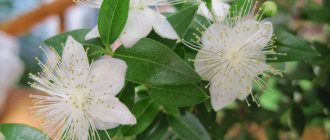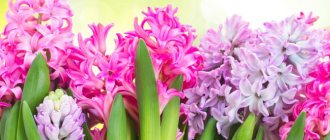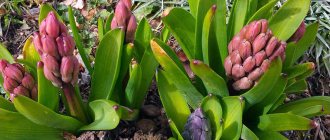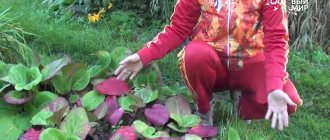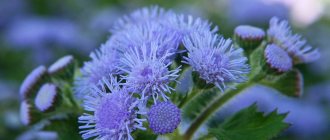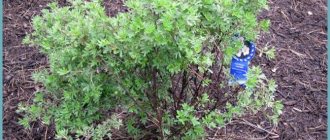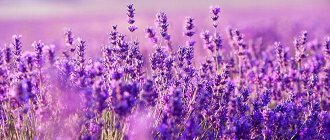Author: Elena N. https://floristics.info/ru/index.php?option=com_contact&view=contact&id=19 Category: Garden plants Published: January 27, 2019Last edits: November 03, 2020
- Growing conditions
- Reproduction methods
- Preparation
- Western thuja (Thuja occidentalis)
plant (lat. Thuja) , or life tree , belongs to the genus of gymnosperm coniferous plants of the Cypress family, like juniper, sequoia, taxodium, cypress and cypress. Thuja was brought to Europe from East Asia or America. The Latin name of the plant has an ancient Greek root meaning “sacrifice”, “incense” - apparently, there is a connection between the name of the plant and the smell of aromatic thuja species ritually burned as incense. The genus includes 6 species, representatives of which sometimes live up to 150 years, although much more mature specimens are also found. In addition to some species, about 120 varieties of plants are grown in culture, differing in the color and quality of the needles and the shape of the crown. Thuja in landscape design is one of the basic plants and is grown as a tapeworm or in a group, and is also used to design alleys, borders, and create hedges.
Planting and caring for thuja
- Planting: possible in the fall, but it is more reliable in the spring.
- Flowering: the plant is grown as an ornamental foliage plant.
- Lighting: bright light in the morning and partial shade in the afternoon.
- Soil: nutritious, sandy loam or loamy.
- Watering: sprinkling method. Newly planted seedlings are watered every week, adults a little less often. Water consumption is from 10 to 50 liters per plant.
- Feeding: in spring, with full mineral fertilizer. If you applied fertilizer when planting, the plant is fed for the first time only after two years.
- Pruning: for sanitary purposes - better in the spring, and formative pruning for thuja is optional.
- Reproduction: species plants can be propagated both vegetatively and by seeds, while varietal plants can only be propagated by vegetative methods: cuttings and dividing the bush.
- Pests: false scale insects and aphids.
- Diseases: brown schutte, cytosporosis, fusarium.
Read more about growing thuja below.
How to organize the sale of what is grown?
If you have decided to organize a small business for yourself, starting to grow thuja at home, you must understand that you will be able to receive full profit from the sale of products no earlier than in a year or two (this is if one-year-old sprouts are sold). But practice shows that most buyers prefer to buy plants that have already grown green mass and will grow quickly after transplanting into open ground. Therefore, while there is a small volume of seedlings in your nursery, and caring for them does not take much time, you need to address the issue of sales.
Video on the topic
Where can I sell thuja?
Since the very first buyers of such products are summer residents, wealthy owners of private estates and households, the best place to offer it to them would be:
- Markets. You can sell it yourself, or you can give it to other sellers for sale. But in this case you will lose on price;
- Trade fairs. A good place where you can not only sell, but also communicate with more experienced gardeners and replenish your assortment with new products;
- Country or farm shops. But please note that in this case, in order to agree on the supply of their products to retail outlets, the owner of the goods needs to register his activity as an individual business.
Of course, if you plan to expand your business in the future, complementing it, for example, with other types of garden plants, then it would be nice if you take care of opening your own store, where you can communicate with customers, help them with choosing plants, tell them about your range of products , backing up stories with useful information about the plants they buy. Over time, such a store can work not only for private clients, but also receive orders from government agencies (arborvitae are bought for decoration of city parks, squares, kindergartens, schools, etc.) But, as mentioned above, this will only become possible if provided that the business is official, and, of course, if the entrepreneur makes enough efforts to promote his business.
How can this be organized?
To get started, you can use the following options:
- Notice boards;
- Banner advertising in areas of dacha buildings:
- Advertisements in the media;
- Targeted advertising on social networks (in thematic groups, specialized pages);
- Advertising on websites selling similar products (over time, you can think about creating your own website or page). By the way, among the 2022 ideas of what to sell in an online store, coniferous products would be a good option. The main thing here is not to forget that not every plant is suitable for this type of sale (after all, they will need to be packaged and sent by mail), therefore, as they say, size matters;
- Word of mouth (this is one of the best methods of advertising, which does not require any effort from the entrepreneur, but only attentive attitude towards customers and good quality products).
In addition to the listed methods of finding clients, sales efficiency can be increased by, for example, preparing a reminder for each buyer on the care of the coniferous plant that is being purchased, attaching a photograph of an already mature plant to it. A good advertisement would be a portfolio of thujas that are in the assortment of your nursery, or created “green” sculptures. You can make business cards so that customers have your number at hand and can call you at any moment and get advice on caring for plants or find out about new products in the range.
In general, in fact, attracting buyers is not so difficult, the main thing is to show imagination, approach this matter creatively, and people will be drawn to you.
Botanical description
Thuja are evergreen shrubs or trees, sometimes in nature reaching 70 m in height with a trunk diameter of 6 m. In cultivation, thuja rarely grows above 11 meters. Young thujas have needle-shaped, soft, light green needles, while adults have leaves of a darker green hue, opposite, scale-like. Thujas are monoecious plants, their fruits are oval or oblong cones with flat seeds that ripen in the first year. Thuja is not capricious in care, it is smoke-resistant, cold-resistant, and a species such as the western thuja tolerates even cold winters well.
Examples of use in landscape design - photos
Flowerbed with thujas and roses
Thuja hedge
Mixborder with conifers
Thuja in the form of a spiral - shaping haircut
Flowerbed with thujas and perennials
Planting thuja
When to plant
Before planting a thuja, you need to choose a suitable site for it. Thuja is light-loving, but being in the sun for a whole day dehydrates it, and this leads to the fact that thuja does not tolerate winter well. Therefore, the place for the thuja should be bright, but at midday the sun should not fall on it. In addition, thuja does not tolerate drafts.
The soil for thuja is desirable to be nutritious - turf soil with the addition of sand and peat, although thuja also grows on less rich soils - swampy, sandy loam and clay. You can plant thuja in spring or autumn, but planting thuja in autumn does not give confidence that the plant will have time to adapt to open ground before winter.
- Ampelous plants: planting and care
How to plant
The size of the thuja pit depends on the size of the seedling's root system - it should be 35-40 cm wider and 15-30 cm deeper than the thuja's earthen ball. If you are planting several plants, the distance between them, depending on the size of adult plants, is kept from 1 to 5 m. When planting thuja along an alley, the distance between seedlings is kept at 3.5-4 m. A mixture of soil with a small amount of compost or well rotted manure.
Before planting, the roots of the seedling should be kept in a container of water until air bubbles stop coming out. After this, place the tree in the center of the hole, straighten the roots, make sure that the root collar is slightly above the soil level, fill the hole with a good soil mixture, carefully and carefully compact it, trying not to damage the base of the trunk, and water the seedling generously at the rate of 1.5- 2 watering cans per plant. When the water is absorbed and the soil settles slightly, mulch the tree trunk with wood chips, peat, compost or pine bark - the mulch will protect the roots of the thuja from too hot or too cold weather and will retain moisture in the soil longer.
However, do not allow the mulch to cover the trunk or lower branches of the plant - they can get stuck under the mulch.
Site selection and soil preparation
For planting thujas, areas exposed to the sun or sparse partial shade are preferred; in this case, the plants develop harmoniously, the needles are fully colored, showing all shades of color, differences in dark and light tones. In deep shade, the crown becomes loose, the needles become sparse, and the color becomes dull.
However, young and dwarf plants do not tolerate full sun; sparse partial shade from nearby clematis, birch or rowan trees is acceptable and desirable. When choosing a location and selecting other crops, it is worth assessing what the green corner will look like in 10–20 years, since this conifer is a long-liver and an initially bright area may turn out to be shady in the future.
Thuja is undemanding to soil and works well in moderately moist neutral, slightly alkaline and slightly acidic soils. It survives on very poor soils, but loses its decorative properties, is stunted in growth, and sometimes begins to bear fruit abundantly, which does not look very attractive on sparse branches.
When choosing a thuja variety, first of all, you should pay attention to the species:
- Western thuja is considered the most versatile species, more resistant to cold than others.
- Eastern thuja tolerates dry, hot periods more easily and is suitable for the southern regions.
- Large thuja in northern latitudes are prone to frost.
Heavy, moisture-saturated soils are not suitable for planting; such areas must be drained in advance, removing excess water. For small plants, it is permissible to arrange drainage directly in the planting hole, for which a layer of broken brick, crushed stone, and expanded clay at least 20 cm thick is poured onto the bottom. Dwarf varieties can be successfully grown in a low-lying area by arranging a rocky hill and planting a tree on its slope.
The area for planting is prepared in advance; for spring planting, in the fall. After cultivation, holes are dug for tall varieties with a diameter of 1 m and a depth of at least 70 cm, for dwarf varieties - at least 50x50 cm. Drainage is immersed in the bottom, then a nutritious, loose hygroscopic substrate is poured, for which the following is mixed:
- turf soil - 2 parts;
- peat – 1 part;
- sand – 1 part;
- humus-powder - 0.5 parts.
After the snow melts, the settled soil is replenished with earth mixture to the previous level.
Caring for thuja in the garden
Growing conditions
Thuja is very responsive to watering, she especially likes sprinkling. In the first weeks after planting, thuja seedlings are watered weekly at the rate of 10-50 liters of water per seedling, depending on its size. If you give young plants sprinkling, this will not only moisten the soil and water the roots of the thuja, but will also wash away the dust from the needles, the stomata of the leaves will open, and the plant will breathe much easier, and accordingly, all physiological processes will proceed faster. After watering, the soil around the thuja is loosened, but not deeper than 8-10 cm, since the plant’s root system is superficial.
Thuja is fed in the spring with complex mineral fertilizer, for example, Kemira-universal solution at the rate of 50-60 g per m². If you applied fertilizer to the soil when planting, then the next time you will need to feed the plant only after two years.
Thuja responds well to pruning - the more often and more strongly it is cut, the thicker and more magnificent it becomes. There is no strict time frame for pruning, but it is better to do this in the spring, before the buds open. If you are growing a hedge of thuja, then you have no choice: whether you want it or not, you will have to cut it. Thuja growing as a solo plant will require at least sanitary and thinning pruning. But if thujas grow in a group, you will have to shape their crowns, otherwise they will look sloppy.
Start forming the crown when the plants have already grown to the size you need. Sometimes one haircut a year is enough - in the spring, but usually there is a need for repeated trimming - in late summer or early autumn. Some forms require constant adjustment of the crown, but no more than one third of the shoot can be cut off at a time, otherwise the plant may weaken. The first pruning of thuja is carried out no earlier than 2-3 years of life. Use sharp, powerful pruning shears for cutting so that it does not chew the shoots or leave dents on them.
This seems to be all the information on how to care for thuja. As you can see, planting and caring for a thuja will not take much of your time, but the healthy appearance of this elegant evergreen plant will certainly make your garden more beautiful.
Transfer
For various reasons, we sometimes have to transplant mature plants from one place to another. Replanting conifers is quite easy if you know how to do it. Around small plants, you need to prick the soil in a circle with a sharp shovel at a distance of 40-50 cm from the trunk, then carefully pry up the plant along with the trunk area outlined in a circle, remove it from the soil, transport it to a new place with a wheelbarrow, trying not to destroy the earthen lump, and immediately plant it. Larger plants need to be pinched a year before transplanting so that they have time to grow new young roots inside a circle-bound earthen coma - as a result, the earth will not fall apart when removed, and transportation will be painless for the plant. In a new place, thuja takes root more easily than other conifers.
Pests and diseases
Thuja is susceptible to fungal diseases such as brown scute, fusarium and cytosporosis, which affect the shoots and needles of the plant. To combat them, treatment with Bordeaux mixture or Kartocide is used - treatment of thuja begins in the spring and is repeated every two weeks until the thuja gets better.
Sometimes readers come to us with the question of why the thuja turns yellow. The fact is that among the insect pests, the plant is pestered by false scale insects and aphids, which is why the thuja turns yellow and its needles fall off. To get rid of parasites, the plant is treated with Karbofos, Rogor or Decis before buds open, and at the end of June it is sprayed twice with Actellik or Chlorophos with an interval of two weeks.
Popular questions and answers
We asked typical questions from summer residents about thujas to agronomist-breeder Svetlana Mikhailova.
How to use thuja in landscape design?
This is a very flexible and unpretentious plant, so there are a lot of options for use. Thujas can be used to make hedges and green rooms in the garden. They look good in compositions of coniferous plants. Dwarf and miniature varieties can be planted on alpine hills and rock gardens.
Do I need to trim the thuja?
Thujas can be cut to give them any shape. For example, with the help of haircuts, you can create hedges and topiaries - sculptures from living plants. In other cases, pruning is not required, but every autumn it is necessary to clear dry needles from the crown - their accumulation provokes diseases.
Why does the thuja turn yellow?
There may be several reasons: - improper planting - the root collar is buried or, conversely, it is above the soil level;
- lack of nutrition - this problem can arise on very poor soils;
- excess or lack of moisture;
- animal urine - if cats or dogs get into the habit of marking thuja, it may eventually turn yellow and die;
- diseases and pests.
Why does thuja dry out?
The reasons may be the same as for yellowing of the thuja. But most often these plants dry out at the end of winter - beginning of spring from so-called sunburn. In the first 2 - 3 years after planting, thujas must be covered for the winter.
Is it possible to grow thuja at home in a pot?
It’s possible, but at home, thujas become very capricious.
They have a dormant period - in winter they require cold keeping with a temperature of 6 - 12 ° C. That is, you need to take them out onto the glassed-in loggia. If you keep them warm all winter, they will die. Sources
- Atroshchenko G.P., Loginova S.F. Assessment of winter hardiness and decorative qualities of various forms of western thuja for landscape design // News of the St. Petersburg State Agrarian University, 2017 https://cyberleninka.ru/article/n/otsenka-zimostoykosti-i-dekorativnyh-kachestv-razlichnyh-form-tui -zapadnoy-dlya-landshaftnogo-dizayna
- Rumyantsev D.E., Vorobyova N.S., Aleksandrov P.S. Features of the growth of thuja occidentalis in the arboretum of the Moscow State Technical University. Bauman, according to dendrochronological analysis // Academy, 2019 https://cyberleninka.ru/article/n/osobennosti-rosta-tui-zapadnoi-v-dendrarii-mf-mgtu-im-baumana-po-dannym-dendrohronologicheskogo-analiza
- Rudenko O.A. Cuttings of coniferous species of the family Cupressaceae in hydroponics // dissertation, 2002 https://www.dissercat.com/content/cherenkovanie-khvoinykh-vidov-semeistva-cupressaceae-na-gidroponike
- State catalog of pesticides and agrochemicals as of July 6, 2022 // Ministry of Agriculture of the Russian Federation https://mcx.gov.ru/ministry/departments/departament-rastenievodstva-mekhanizatsii-khimizatsii-i-zashchity-rasteniy/industry- information/info-gosudarstvennaya-usluga-po-gosudarstvennoy-registratsii-pestitsidov-i-agrokhimikatov/
Reproduction of thuja
Reproduction methods
Thuja reproduces both generatively and vegetatively. If you are propagating a species of thuja, you can do it with seeds. But varieties and forms must be propagated vegetatively - by cuttings or dividing the bush, since thuja from seeds does not retain the varietal characteristics of the parent plants.
Propagation by cuttings
Propagation of thuja by cuttings is carried out using lignified two- to three-year-old shoots 25-40 cm long, or semi-lignified shoots of the current year, 10 to 20 cm long, cut in June. Thuja cuttings are not cut, but torn off with the heel, the place of separation from the mother plant is treated with a solution of heteroauxin, planted to a depth of 1.5-2.5 cm in a mixture of equal parts of turf soil, peat and sand, spilled for disinfection with a warm solution of potassium permanganate, and cover the planting with plastic film.
- Stratification and scarification of seeds - which plants need them and how to carry them out correctly?
For successful rooting of cuttings, it is necessary to maintain high air humidity in the greenhouse without waterlogging the substrate, so the soil is not watered, but sprayed with a sprayer. As soon as the cuttings take root, they begin to be ventilated and gradually hardened until it is time to remove the film. With the onset of deep autumn, the cuttings are covered with dry leaves, sawdust, or preferably spruce branches, and if the temperature drops to -5-7 ºC, a film is thrown over the spruce branches.
Growing thuja from seeds
In order to grow a thuja from a seed, you will need three to five years. You only need to sow freshly harvested thuja seeds, having previously subjected them to natural stratification from autumn to spring under the snow or in the refrigerator. In spring, seeds are sown in beds located in partial shade to a depth of only 0.5 cm and lightly sprinkled with sawdust from coniferous trees. Then the crops are covered from the sun with shields, and the soil is kept loose and slightly moist at all times. After the emergence of seedlings, the area is mulched with peat.
Twice a month the seedlings are fed with a solution of complete mineral fertilizer. During the first season, seedlings usually grow up to 7-8 cm. For the winter, young thujas are covered with spruce branches and a film on top. Next spring, the cover is removed, and the seedlings are cared for as last year - the soil is mulched, watered, weeds are removed and fed. In the third spring, when the plants reach a height of 50 cm, they are planted in a permanent place.
Preparing thuja for wintering
In autumn, thuja should be watered abundantly, using a drug to stimulate the root system. Fertilizing with nitrogen fertilizers is useful. It is imperative to carry out sanitary treatment with the removal of diseased and broken branches. Young trees are insulated with a special covering material that allows the sun's rays to pass through. When propagating thuja by cuttings in winter, they require special attention and care. Tree roots also require protection. To do this, the tree trunk circle is covered with a thick layer of fallen leaves. If the crown of the thuja is spreading, their branches are carefully tied together with a wide ribbon so that the tree branches do not break under the weight of the snow. Young trees should be tied to supports, and to protect them from severe frosts, they can be covered with straw bales.
At the end of winter, when the sun begins to warm up, and also at the beginning of spring, seedlings sometimes suffer from direct sunlight, which can cause burns on young trunks. Therefore, in the first year of wintering, the plants are covered with burlap. There are special anti-sunburn preparations for treating trees. After winter, the bark of some trees may become covered with cracks; it is recommended to lubricate them with garden varnish; the wounds will then quickly heal.
Thuja in winter at the dacha
Preparation
In the fall, both watering and fertilizing of the thuja are stopped, since the plant must prepare for the dormant period.
How to cover for the winter
Young plants that are under five years old need to be covered with spruce branches for the winter. Before covering the thuja for the winter, it is hilled up high, and the tree trunk area is mulched with a thick layer of peat. Adult plants overwinter without shelter, but it is necessary to mulch the area around them.
Wintering of thuja
If too much snow falls in winter, it can break the thick crown and branches of even an adult large thuja. To prevent this from happening, thujas are tied with twine for the winter. At the end of winter, so that the thuja does not suffer from the strong spring sun, a non-woven covering material is thrown over it. Sometimes, due to sudden temperature changes in winter, cracks form on the thuja bark. In the spring, they are covered with garden varnish and the bark is pulled tightly so that the wounds heal.
How to choose seedlings when purchasing?
How to choose thuja seedlings?
Seedlings are purchased from nurseries or garden centers with a solid reputation. The best option is plants in containers with a closed root system. Such planting material can be planted at any time of the year, but the optimal period is spring, in which case the thuja will have time to take root, and the resulting growths will ripen well by winter.
If a nursery sells seedlings “from the field,” it is advisable to pick them up as quickly as possible. At the same time, they try to keep a lump of damp earth on the roots by wrapping it tightly with burlap or film.
You should not purchase seedlings with an open root system, especially “from hand” on the market; they may turn out to be not only weakened, with dried roots and shoots, but also infected with a fungal infection, for example, rust.
When choosing planting material, pay attention to the correspondence of the shape of the crown and the color of the needles to the required variety. It is better not to take plants with bare branches and browned crowns.
If long pieces of roots stick out through the drainage holes in the container, the seedling is rejected. If the roots have just appeared, this means that the earthen ball is well mastered by the root system and the plant will take root better.
Types and varieties
Western thuja (Thuja occidentalis)
When we talk about cultural thuja, we primarily mean the type of thuja occidentalis - it is this species that is represented in our gardens, parks and squares by a huge number of its varieties, forms and varieties. In Europe, it was introduced into culture in the 16th century. Large specimens of this species reach a height of 8-12 m. Western thuja is a long-liver among trees, it can live up to a thousand years. At a young age, it is a pyramidal tree; subsequently, the shape of the crown becomes ovoid.
For landscaping, pin-shaped, cone-shaped or column-shaped plants are usually used. For example:
- Thuja Brabant is a tree 15-21 m high with a conical crown with a diameter of 3-4 m. The bark is exfoliating, gray-brown or reddish. The needles are green and scaly. Thuja cones of this variety are oblong-ovate, brown in color, up to 12 mm long;
- Thuja Smaragd is a squat variety up to 2 m high with a cone-shaped crown and weak branching. The vertical shoots have glossy evergreen branches widely spaced from each other. Planting and caring for thuja Smaragd is carried out in accordance with the recommendations in this article. The variety is in great demand.
Among the group of varieties with a spherical crown shape, the most famous are:
- thuja Danica - a dwarf form of thuja of Danish selection with gray-brown or reddish exfoliating bark, thick, soft, shiny green scaly needles, which acquire a brownish tint in winter;
- Thuja Woodward is a spherical thuja of dwarf size - no higher than 2.5 m with a crown diameter of 5 m. Its shoots and branches are straight and flat. The needles are dark green.
Gardeners are also attracted to varieties of cascading, thread-like shape, which include:
- Thuja Filiformis is a tree up to 1.5 m high with a dense round or wide cone-shaped crown, long thread-like hanging shoots that almost do not branch. Young needles are light green; in winter they turn brown.
Not long ago, a heather-like form of thuja was developed, for example:
- Thuja Erikoides - no more than a meter high, reminiscent of a juniper, with a rounded multi-vertex wide-conical crown, numerous thin flexible shoots, straight or curved, and awl-shaped soft needles, matte yellow-green above, gray-green below. In winter the needles turn brown.
A form has also been developed with two types of needles on one plant - needle-shaped and scale-shaped, with a strange growth of the crown: at 8-10 years of life it breaks up into several tops and instead of one thuja a group of plants is formed.
Thuja plicata
The species also grown in culture is the thuja foldata, or giant thuja, which grows in nature along the Pacific coast and is the highest mountain species of thuja. It reaches a height of 60 m with a trunk diameter of 3-4 m, although in culture its achievements are not so high. Thuja foldata has several decorative forms, of which the most famous is Zebrina.
Korean thuja (Thuja koraiensis)
It is a wide shrub or tree up to 9 m high. The needles are elegant, whitish, almost silver. However, this attractive plant needs shelter in winter.
- Hemlock: properties and contraindications, types
Japanese thuja (Thuja standishii)
grows in its natural habitat, in the mountains of Central Japan, up to 18 m in height, it has a wide cone-shaped crown with copper-red bark and silvery branches on the underside, which, when rubbed, smell like eucalyptus caramel and lemon. In cool areas, thuja japonica grows slowly; in warm areas, growth accelerates noticeably.
Oriental thuja (Thuja orientalis), or flat branch (Platycladus)
separated into the subgenus biota, of which it is the only representative. In nature, it grows in China, and in culture it has been bred for several centuries in Central Asia. It is a large shrub or spreading tree with a lacy crown that is widely used in landscaping. Thuja orientalis has more than 60 garden forms, unfortunately, not winter-hardy.
We introduced you to the variety of types and forms of one of the most beautiful and unpretentious coniferous plants, but only you can decide which thuja will decorate your yard or garden. However, no matter what plant you choose, with proper care it can delight your eyes for decades.
Diseases and pests
Among coniferous trees, thuja is the least susceptible to disease. But even she still succumbs to the onslaught of fungal pathogens. Some of them, at a certain level of infection, can cause quite serious harm. Fungal pathogens usually cause necrosis, destroying the branches and crown of the thuja. In addition, scientists identify 7 types of pests that feed on wood trunks, pine needles and immature green cones.
Pests
Most pests are oligophages. They infect all species of plants of the cypress family. They live mainly in the Caucasus and Crimea.
Three groups of pests:
- sucking
- xylophagous
- miners
Sucking pests include aphids (one species) and coccids (two species). They feed on the juice of shoots, cones and pine needles.
The most harmful to these plant species are the thuja false scale insect and the juniper scale insect. The body of the female thuja false scale is spherical and strongly convex, brown in color, 3.5 millimeters in length. This pest lives in the European part of Russia, as well as in the Caucasus and Crimea. Females of another insect have an oval brown shield about 2 millimeters long. They live in Transcaucasia, Central Asia and the European part of Russia.
Aphid.
The thuja aphid is found extremely rarely on thujas, but is also considered a thuja pest. The body of the thuja aphid is brown in color with a light coating. They feed in small flocks on the inside of young branches.
The needles damaged by aphids die.
Miners are insects that gnaw tunnels in leaves, thus feeding on needle tissue.
One of the representatives of this type of insect is the thuja leaf miner. This baby eats the inside of the scaly thuja leaves. The results of these caterpillars can be seen by looking at the needles up close.
Damaged needles turn yellow and their shoots die. Emerging from the yellowed needles, the caterpillars of the thuja leaf miner leave behind them clearly visible small holes.
Xylophagous insects are pests that feed on bark, trunks and branches. They prefer the weakest plants.
The two main types of thuja bark beetles are the thuja beetle and the juniper bark beetle. They live in the Caucasus and Crimea.
Diseases
- Pestalocyopsis necrosis.
Affected leaves and shoots turn red. The damage spreads from top to bottom. Scattered black bumps appear on dead leaves and bark and protrude from cracks in the cover. A sign of the disease are black drops on the leaves, in the form of which spores of the damaging fungus appear on them.
- Phomopsis necrosis.
Branches and leaves affected by this type of fungus become brown in color.
Sporulation of this type of fungus is localized in black tubercles in the leaves and on the bark, and mature spores are formed in light drops on the affected surface.
Phomopsis necrosis.
- Cytospore necrosis, or osteoporosis.
It affects branches and trunks, and in rare cases, leaves of the plant. The color of the affected leaves becomes brown. The sporulation of pathogens looks like very small conical pimples with black tips. It is by this sign that the disease can be detected. Ripe spores resemble yellow-red droplets in appearance, sometimes flagella or spirals.
- Diplodia necrosis, or diplodiasis.
It equally affects trunks, branches and leaves. The color of the bark remains almost unchanged, but the leaves become brown. The sporulation that forms on dried areas looks like black tubercles.
- Brown Schutte.
Leaves that are covered with snow in winter suffer, since the causative agent of this type of fungus itself develops only under the snow. When the snow melts, the branches are covered with brown mycelium, which glues the infected young branches together.
The most dangerous pathogens for an adult plant are the so-called root rot pathogens: flat tinder fungus, autumn honey fungus, sewing tinder fungus and root sponge. As a rule, weakened tree specimens are susceptible to all of the diseases listed above.
Brown Schutte.
Basic rules of care
Only proper and regular care of the thuja will allow it not to lag behind in growth and not get sick. Let's consider the main recommendations:
- An area with partial shade or low light is suitable for growing. The soil must be fertile, then the crown will be lush and bright.
- In summer, thuja needs regular and abundant moisture. You can use warm, settled water.
- Fertilizing should be done from late spring to early autumn. Specialized formulations for coniferous crops are best suited.
- Regularly inspect the plant for insects and diseases. For example, if the needles are covered with unsightly dark spots, then these are sunburns, which are difficult to get rid of.
Pros and cons of seed propagation
The main advantage of this method is obtaining an unlimited number of seedlings at no cost. At the same time, their age will be the same, which will make the gardener’s task easier.
Such plants can be planted along the fence, used to form a hedge. In addition, thuja grown from plant seeds from your own plot will take root well and will develop fully.
The disadvantage of using seeds is the lengthy growing process. From the moment of sowing until the seedlings are planted in the ground, at best, 4 years pass. Sometimes planting material partially loses its varietal characteristics, so the shape of the shrub crown may change.


